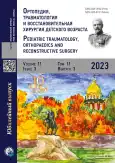Flexion–distraction injuries of the spine: Features of diagnostics, clinical picture, and results of surgical treatment of children
- Authors: Filippova A.N.1, Kokushin D.N.1, Khusainov N.O.1
-
Affiliations:
- H. Turner National Medical Research Center for Сhildren’s Orthopedics and Trauma Surgery
- Issue: Vol 11, No 3 (2023)
- Pages: 285-291
- Section: Clinical studies
- Submitted: 29.05.2023
- Accepted: 17.07.2023
- Published: 29.09.2023
- URL: https://journals.eco-vector.com/turner/article/view/464680
- DOI: https://doi.org/10.17816/PTORS464680
- ID: 464680
Cite item
Abstract
BACKGROUND: Flexion–distraction injuries of the spine result from high-energy trauma (traffic accidents and falls from a height). This type of injury is commonly found in the thoracolumbar junction. Among combined injuries in the presence of flexion–distraction fractures of the vertebral column, injuries of the chest or abdominal organs are often observed, which are crucial for patient survival, and their diagnostic measure is complex because of the severe and unstable conditions of the patients.
AIM: To analyze a cohort of pediatric patients who underwent surgery for flexion–distraction injury of the spine.
MATERIALS AND METHODS: We analyzed the data of clinical and instrumental studies and surgical outcomes of 28 pediatric patients (aged 2–17 years) with flexion–distraction injuries of the spine. The standard preoperative examination included clinical and laboratory studies, spondylography, multislice spiral computed tomography and magnetic resonance imaging of the damaged area, electrocardiography, and ultrasonography of the abdominal organs and kidneys. All patients underwent surgery for the correction and stabilization of traumatic spinal deformity with a multisupport metal structure and posterior local fusion. The analysis included an assessment of the mechanism of injury, concomitant injuries, time elapsed after the injury before admission to the hospital, level of the damaged segment, and treatment. Data were processed statistically using an online calculator. The nonparametric Mann–Whitney method was used.
RESULTS: Catatrauma was the leading cause of injury in 50% of the patients, compared with traffic accidents in 36%. In 80% of the patients, spinal injury was localized at the thoracolumbar junction and lumbar spine. Moreover, 71% of the patients were transferred to the National Research Center for Children’s Orthopedics and Trauma Surgery for surgical treatment on the spine in the early stages after injury (up to 7 days), and 8 children (19%) were admitted within 10–45 days (average 16 days). In 19 (68%) patients, in addition to spinal injury, concomitant injuries occurred, with skeletal trauma and injuries of the abdominal cavity organs as the most frequent. All patients achieved complete correction of the deformity at the level of the damaged segment.
CONCLUSIONS: Flexion–distraction fractures of the spine in children are characterized by a high incidence of concomitant injuries, which dictates the need for a full examination to identify them and correctly interpret the data. The elimination of mechanical instability in the early stages in this type of injury can reduce the extent of fixation and contribute to the restoration of the physiological profile and disk apparatus of the spinal column.
Full Text
About the authors
Aleksandra N. Filippova
H. Turner National Medical Research Center for Сhildren’s Orthopedics and Trauma Surgery
Author for correspondence.
Email: alexandrjonok@mail.ru
ORCID iD: 0000-0001-9586-0668
SPIN-code: 2314-8794
MD, PhD, Cand. Sci. (Med.)
Russian Federation, Saint PetersburgDmitriy N. Kokushin
H. Turner National Medical Research Center for Сhildren’s Orthopedics and Trauma Surgery
Email: partgerm@yandex.ru
ORCID iD: 0000-0002-2510-7213
SPIN-code: 9071-4853
MD, PhD, Cand. Sci. (Med.)
Russian Federation, Saint PetersburgNikita O. Khusainov
H. Turner National Medical Research Center for Сhildren’s Orthopedics and Trauma Surgery
Email: nikita_husainov@mail.ru
ORCID iD: 0000-0003-3036-3796
SPIN-code: 8953-5229
Scopus Author ID: 57193274791
ResearcherId: AAM-4494-2020
MD, PhD, Cand. Sci. (Med.)
Russian Federation, Saint PetersburgReferences
- Chance QC. Note on a type of flexion fracture of the spine. Br J Radiol. 1948;21:452–453.
- Vissarionov SV, Pavlov IV, Gusev MG, Lein GA. Complex treatment of patient with multiple fractures of the vertebrae in the thoracic spine. Traumatology and orthopedics of Russia. 2012;(2(64)):91–95. (In Russ.)
- Arkader A, Warner W, Tolo V, et al. Pediatric chance fractures: a multicentre perspective. J Pediatr Orthop. 2011;31:741–744. doi: 10.1097/BPO.0b013e31822f1b0b
- Suttor S, Gray R, Bridge C, et al. Operative treatment of chance injuries in the paediatric population. Eur Spine J. 2013;22(3):510–514. doi: 10.1007/s00586-012-2582-7
- Daniels AH, Sobel AD, Eberson CP. Pediatric thoracolumbar spine trauma. J Am Acad Orthop Surg. 2013;21(12):707–716. doi: 10.5435/JAAOS-21-12-707
- Henry DA, Bumpass DB, McCarthy RE. Delayed diagnosis of a flexion-distraction spinal injury and occult small bowel injury in a pediatric trauma patient: importance of recognizing the abdominal “seatbelt sign”. Trauma Case Rep. 2021;34. doi: 10.1016/j.tcr.2021.100499
- Andras LM, Skaggs KF, Badkoobehi H, et al. Chance fractures in the pediatric population are often misdiagnosed. J Pediatr Orthop. 2019;39(5):222–225. doi: 10.1097/BPO.0000000000000925
- Knox JB, Schneider JE, Cage JM, et al. Spine trauma in very young children: a retrospective study of 206 patients presenting to a level 1 pediatric trauma center. J Pediatr Orthop. 2014;34(7):698–702. doi: 10.1097/BPO.0000000000000167
- Durbin DR, Arbogast KB, Moll EK. Seat belt syndrome in children: a case report and review of the literature. Paediatr Emerg Care. 2001;17(6):474–477. doi: 10.1097/00006565-200112000-00021
- Schiedo RM, Lavelle W, Ordway NR, et al. Purely ligamentous flexion-distraction injury in a five-year-old child treated with surgical management. Cureus. 2017;9(4). doi: 10.7759/cureus.1130
- Krafft PR, Noureldine MHA, Jallo GI, et al. Percutaneous lumbar pedicle fixation in young children with flexion-distraction injury-case report and operative technique. Childs Nerv Syst. 2021;37(4):1363–1368. doi: 10.1007/s00381-020-04845-7
Supplementary files












